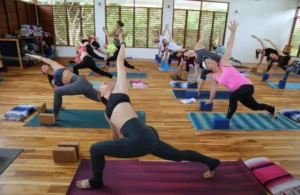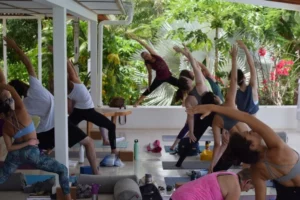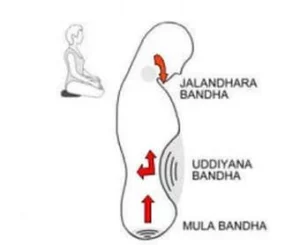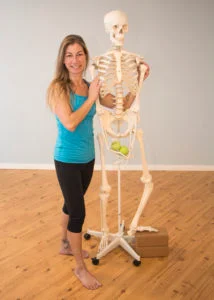Updated 10/5/24
The fascinating fascia in yoga! Fascia in yoga asana is all the buzz at this time and frankly, I am thrilled. New research out on interstitial tissue and fluids classified fascia is a part of this newly termed “organ” system.
Facia in Yoga – our Extracellular Matrix

But before the excitement of the interstitial tissues, many of us in the movement worlds were in love with and interested in the myofascial tissues. Our Extracellular Matrix is indeed fascinating. It is our support system, and information highway. It is our force distribution system that creates our physical shape as well as shares messages with all systems of the body. The fascia conducts light– we are all light beings after all! Because the fascia responds to hormones and chemicals released, scientists also believe that the network stores memory of our experiences. At this time, there is also research being done on how the fascia conducts “Qi”, our energy, through the meridians.
Anatomy Trains
Tom Myers has also found what he calls the Anatomy Trains. These are lines of fascial tissues helpful for teaching fascia in yoga that can be dissected out of the body. The line that is the most interesting to me, as a movement therapist and yoga therapist, is the Deep Front Line (DFL). I have had the honor of seeing this amazing tissue removed from the body, in one piece! When I think of our main “support system” of the body, our Core, I think DFL.
In the past, it has been common to train the peripheral abdominal muscles as our “core” strength. It’s not a problem and in fact beneficial to focus on the abdominal muscles. However, we have been missing the most important piece of our deep core stability. I have worked to rehab plenty of very strong athletes, that even have the 6 pack in the abdominals, who have injured their spines through heavy lifting and fighting.
Facia as The Heartwood
This is due to the fact that they were never taught about their DFL, what I also call our Heartwood. If a tree does not have a strong heartwood, deep center, they will not take root properly. As their branches grow larger, the roots and heartwood cannot sustain and balance the weight. In the early 90’s, there was an experiment conducted in a space station. Plants and trees were being grown in a very specific biosphere. To the scientists’ surprise, all of the trees died and fell over.
The discovery made was that the heartwood of the trees was weak. It could not support the whole system of the tree. This is how I experience our human, inner heartwood. If we are not stable, strong (and flexible) through our centers, then the peripheral movement we make can create injury. This is especially true of the lumbar spine that has no support internally from the DFL.

Anatomy of the Deep Front Line (DFL)
The DFL originates at the Plantar Tarsal bones, at the base of the pad of the big toe. It runs along the inside of the ankle, up the Tibialis Posterior into the back of the knee. Crossing over to the Medial Femoral Epicondyle, up the back of the Hamstring to the Lessor Trochanter of the Femur. It has a connection to the Ischial Tuberosities (sits bones) and the Coccyx (tailbone). On the front side of the body, it runs up the pelvis and includes the Psoas, Pelvic Floor and the Diaphragm. It does not include the abdominal muscles! Interesting, right?
The line continues through the deep muscles of the throat. This includes the Xiphoid Process in the throat and ends at the tip of the tongue. Yes, in dissection the muscles of the throat and the tongue are the last to slide out. The line is gently pulled from the body cavity. Now, Tom does include the fascia of the mandible in this line, although it is not attached physically. This line of fascia also keeps attachment to all of the lumbar vertebrae. On one hand it seems quite complex. However, once we get to know this system intimately, it all makes much sense. Yoga is a great lens to look through here, to see the intention of the support system as well as to validate the ancient wisdom of yoga.
The Deep Front Line (DFL) vs. the Bandhas

If we compare the Bandhas, with the DFL train, we will find that it is supporting Mula Bandha (small portion of the pelvic floor lift), Uddiyana Bandha, though the solar plexus and diaphragm as well as Jalandahara Banda in the throat. Can you believe it? The Deep Front Line discovery supports the “lifts” or “locks” of the core!
But even more significant, is that this deepest part of ourselves is meant to be the support system for the spine and we leave it out of “core work”. Now, in a yoga practice, we can address this system, beginning with the stability, balance and function of the feet. Pada Bandha, the foot lock, is a great place to begin.
Experience facia in yoga
I often will ask students to use a foam block between their thighs in asana such as Plank, Uttanasana, Utkatasana. This aids in discovering the strength of the DFL, through the Adductors (inner thighs). We often chronically underuse the inner thigh muscles. This leads to an imbalance in the strength of our legs. It also causes an underuse of the muscles and fascia that support our lumbar spines from the front and the back of the body.
For example:
In Utkatasana, chair pose, it is common for the tailbone to stick up or tuck under, the lumbar spine to be compress, the belly to hang forward and THEN the head looks up! Oye! When the asana presents like this, there is little to no core support from the inside out. No wonder many students report back pain in this pose.
Take a block, preferably foam, in between the inner thighs. Inhale and sit back into a chair, just allow the block to be there for a moment with no action. Heel-toe the feet a little closer together if need be for more contact with the block. Without ANY action intended for the tailbone, begin to slowly draw the energy of the inner thighs towards the block. I am not a fan of the word “squeeze.” However, in the beginning, it may feel as if you need to squeeze a bit more to begin to strengthen the action.
Alignment of the Deep Front Line (DFL)
What you are looking for is the draw of the low belly in towards the spine and slightly up, from the top of the pubic bone to the navel center. The tailbone will drop into its natural alignment with your needing to initiate any movement. As the tailbone drops, there will be more space in the sacrum and the lumbar spine.
Please resist the urge to look to the sky. Instead, lengthen the back of the neck and bring your chin in line with the sternum. As soon as we look upwards and open the front of the throat, we have lost the connection to the whole chain. If you don’t believe me, try it. It usually feels pretty awful to tilt the head back. Once we have felt the connection to the lower portion of the train. You might also use a block at the base of the skull to aid in the positioning of the head, at the beginning.
This is my favorite asana to use for connecting to our heartwood of the DFL and for exploring fascia in yoga. There are always lightbulbs that go off in the room. Students smile, laugh, and are finally at ease in Utkatasana. I can’t tell you how often I hear, “this used to hurt my back!”. Well, of course it did. You previously didn’t know how to connect to the deepest part of your support system.
Join Yoga S.A.F.E. for more on Facia in Yoga
Do you have interest in to learning more about fascia in yoga and the DFL or yoga for back care? Join online course Yoga S.A.F.E. – Sustainable and Safe Adaptations of Yoga for EveryBODY. You can enroll and begin this 5 week course toay! Enjoy lifetime access and ability to watch on your time. More information for your enjoyment HERE!
For now, enjoy playing with and learning more about ways to bring fascia in yoga and the DFL into students awareness and into their hearts.
Contributing author: Samantha Akers, E-RYT 500, C-IAYT, CMT, MFRT

Sam began practicing yoga in 2000, after being diagnosed with Chronic Fatigue and Fibromyalgia. She is an expert on fascia in yoga and also credits Restorative Yoga and meditation, to her healing. She became increasingly interested in the Therapeutic Style of Iyengar Yoga and studied Therapeutics with Judith Lasater, Leeann Carey and Russ Pfeiffer. Samantha is also a massage therapist, a fascia buff and a dedicated student Tom Myers.